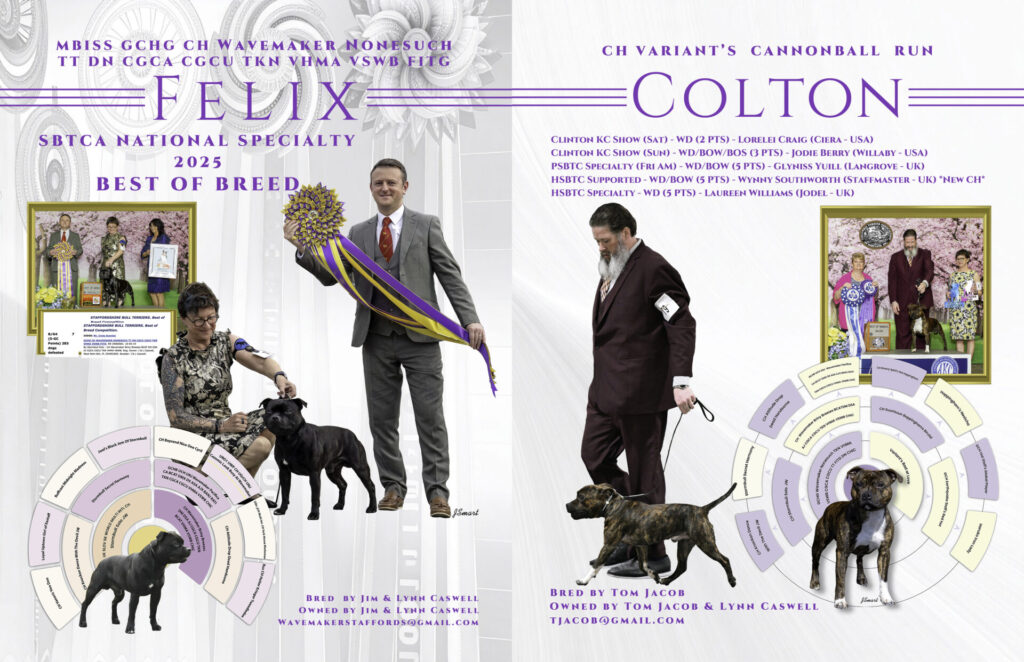NBISS MBISS GCHG CH Wavemaker NonesuchTT DN CGCA CGCU TKN VHMA VSWB FITG CHIC
Top Stafford in USA 2023 and 2024 (Specialty stats)
SBTCA #1 Stafford 2023, 2024
BEST OF OPPOSITE SEX 2024 SBTCA National Specialty, Golden Jubilee – St. Louis, MO under Judge Melanie Corcoran
BEST OF BREED 2025 SBTCA National Specialty – Timonium, MD – under judge Craig Scanlan
- Specialty Best of Breed wins = 11 as of September 2025 (previous record = 7)
- Best of Breed wins under Stafford specialist judges: 17
- Best of Opposite wins under Stafford specialist judges: 8
- Select Dog wins under Stafford specialist judges: 16
- Terrier Group placements: 11 (including the ONLY Stafford to place in the Brooksville Cluster groups and he did it twice, Plus a BBE G2 at Montgomery County KC)
- Top 20 Winner: 2023
- Top 20 Peoples Choice Winner: 2023, 2025
- Judi Daniels Award: 2025
Terrier Variety Group placements:
- G4 Heartland KC – Tampa, Fl (Jay Richardson)
- G2 Toledo KC – Maumee, OH (Geir Flyckt-Pedersen)
- G4 Columbus KC (Roz Kramer)
- G3 Hernando Cnty KC, Brooksville, Fl (Sharol Candace Way)
- G3 Columbus KC (Fred Bassett)
- G4 Virginia KC (Polly Smith)
- G4 Travis County KC (Steve Hayden)
- G4 Pasco Fl KC (Darryl Vice)
- G2 Sunmaid KC, Fresno, CA (Sally George)
- G3 Greater Orange Park DC – Elkton, Fl (Darryl Vice)
- G4 Baltimore County KC (Darle Heck)
Westminster Kennel Club:
2023 – Select Dog (Jerry Klein)
2024 – Select Dog (Joe Vernuccio)
Westminster Kennel Club Invitations: 4
Montgomery County Kennel Club:
2021 – Best of Breed – Jason Nicolai – made the cut in both groups, Variety, BBE
2024 – Best of Breed – Fiona McBride – Made the cut in Variety and placed G2 in BBE
Crufts Qualifications: 5
Clear by DNA – L2-HGA, HC, DM, OFA Eyes 2019, 2021, 2023, 2025
CHIC #165184
Patella, Cardiac, PennHIP L 0.43 & R 0.45, OFA Thyroid, OFA Dentition – correct scissor bite, no missing teeth, OFA Elbow Normal, Nares clear/open – no evidence of elongated soft palate, no evidence of Esophageal Malformation (by sedated scope – Dr. McGuffin, OH).
Full IDEXX semenalysis report available.
D/D, KB/ky, Ay/at, E/E, B/B
‘Felix’ is available at stud on a very limited basis. Email to inquire. Sorry, no frozen or fresh chilled currently available. Live cover only. He has produced black brindle, mahogany brindle, red, red with mask and BB with white.



























